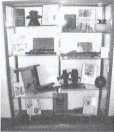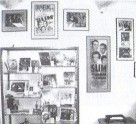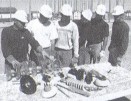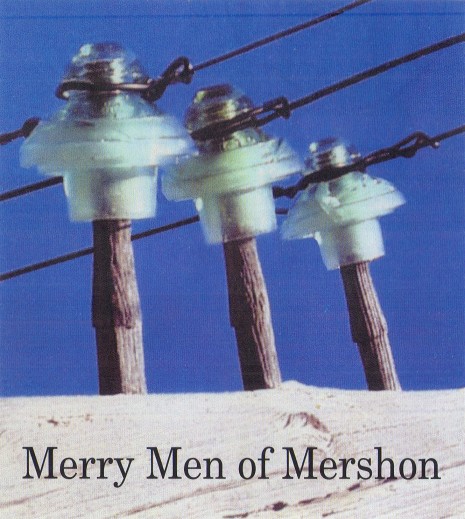An Unexpected Find For Northwest Lineman College
by Alan Drew, Vice President Northwest Lineman College
Reprinted from "Crown Jewels of the Wire", November 2000, page 10
I have been in the electric power utility business for many years as a
lineman and an electrical engineer in California and Washington. I have always
been interested in insulators and related materials along with any associated
history. About two years ago I moved to Boise, Idaho looking towards retirement
and started working at Northwest Lineman College. The college provides various
types of power line training with the main focus on teaching students to climb
poles and work on power lines.
We make a special effort to teach the students
the history of power generation, transmission and distribution so they can have
a better understanding of how the trade has improved and how much safer the work
has become.
To this end, we have an impressive historical exhibit of various
historical items related to the power and communications field including
insulators. The students learn the evolution in the designs and application of
insulators. We also stress the importance of cleaning insulators before
installation as well as methods to clean insulators in the field when the lines
are energized.
The Lineman's Handbook has been the standard reference for lineman since the
first issue in 1928. The college has established a tribute to the book with
support from the authors and their families. On display are a complete set of
all nine editions along with pictures and memorabilia about the authors E.B.
Kurtz, Thomas Shoemaker and the current author James Mack.

The college has
another significant tribute to the movie and book 'Slim', by William Wister
Haines. Both the book and the movie, which were done in 1934 and 1937
respectively, have a great nostalgic value and are very popular with lineman.
Slim is the story of a lineman booming around the country working on power
lines. The college sells some great shirts with linemen artwork from the book.

The president and founder of the college,
Aaron Howell, has a keen interest and a strong commitment to enhancing our
historical exhibit. Our insulator display is very popular with the students and
they are surprised at the variety of styles and colors.


Students receiving instruction on various types
of insulators in the outdoor
instruction yard
and in the display area of the college lobby.

In our continuing efforts to enhance or exhibit research of some of the local
Idaho Power companies, studies resulted in the knowledge of an old line
relatively close to the school.

Original Swan Falls hydro plant.
The line to Silver City exited
the plant to
the left of the plant.
About twenty miles south of the college is the Snake River and the historic
Swan Falls Hydroelectric Plant. The plant has been modernized, however the old
powerhouse remains along with some of the very early equipment. It is open to
the public and is very interesting. The high voltage buss supported by early
multipart insulators is still in place. Anyone visiting the Boise area with an
interest in this early equipment should plan to visit the plant.
After doing
some research I learned that the plant was built in between 1899 and 1901 and
its primary purpose was to provide power to the mining area near Silver City
which is located in the Owyee mountains approximately 27 miles southwest of Swan
Falls. In 1901 a three-phase power line designed to operate at 22,000 volts was
built from Swan Falls to Silver City. Further research indicated the line used
the Mershon type insulators for the entire line. The line was removed in the
1930's with the termination of productive mining in the area.

COVER: Alan Drew, of Boise, Idaho, provides the cover photo
of Mershons in service. Wonder if he knows a lineman that has a bucket
truck and camera and would provide him with a close-up photo? Hmmmmm? Read
the story beginning on page 10. |
The president of Northwest Lineman College Aaron Howell and I got a map of
the line showing the actual route, pole locations and span lengths from Idaho
Power and made some field trips without any success. We were able to find some
pieces of the original pole tops but no insulators.
In November of 1999 I was
pheasant hunting on a ranch in the Owyee mountains near the route of the line. I
finished hunting and was driving to the rancher's house to thank him for the
hunt. As I was driving along the dirt road I noticed an old line supplying power
from the ranch house to the barns. As an insulator collector you are always
looking at the type of insulators. I could see that one of the poles had three
green glass insulators. I took out my binoculars and "bingo" there
were the Mershons. I had never seen wood pins installed in this manner, however
they securely mounted the insulators and wire.
I asked the rancher if he would
mind if I came back hunting the next week and if it would be all right to
replace the insulators. He readily agreed and the next week I brought my
climbing gear, three replacement Hemingray 19s, and my shotgun. After a
successful pheasant hunt I changed out the insulators and thanked the rancher.
Before I climbed the pole I made a special effort to determine if the pole was
okay to climb. I dug down about a foot and sounded the butt of the pole with a
hammer. Any hollow sound can indicate decay and a pole that may not support your weight,
especially when the Wires are untied. I also took the digital camera up the pole
to get a good shot of the insulators in use.

One of the insulators was a nice
green color and the other two were more aqua. We now have a Mershon in our
display of power insulators at the school. I plan to make more field trips and
see if I can find any of the original crossarms and pins that I can put in our
display at the school.
I asked the rancher about the insulators and he said that
they had been there as long as he could remember. Apparently when the line was
removed in the 1930's the rancher at that time salvaged them and used them for
his farm line.
The moral of the story is:
If you are prospecting a line, also check ranches
in the vicinity as ranchers seem to be able to use any materials associated with
telephone and power lines. Also, if any of the readers happen to be in the Boise
Idaho area, you are encouraged to stop by and visit Northwest Lineman College.
| 